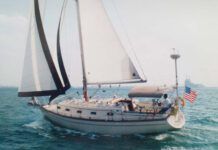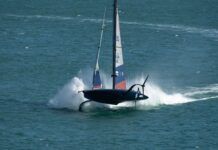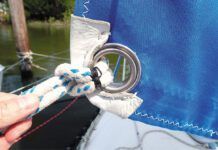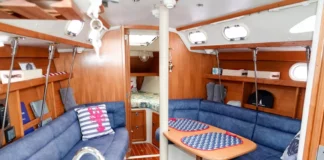Plotters vs. Paper Charts
For two years now I have been without a boat, but continue to subscribe and read with great interest each issue as it comes. After reading the current issue in which various plotters and depth sounders are compared, and having read many references regarding the need for paper charts, etc., I have finally decided to throw my hat into the ring.
About seven years ago, I purchased a Garmin GPS190 plotter. After installing the unit in my vessel, I found that the unit would not lock into my location. After several talks with Garmin tech staff, it was determined that the problem was in the antenna. After a swap with the dealer, the system locked in without a problem and we went merrily on our way.
After a six-month lay-up, the same problem occurred again. Another new antenna. We went on for a couple of years without mishap, but then began to notice beads of moisture on the screen. This was no particular problem, but since the system is presumably sealed with nitrogen under pressure, we returned the unit to Garmin and the company resolved the problem after the season’s end.
After having survived a couple of episodes of vandalism on our vessel, we became nervous about the plotter and removed it whenever we left. Then one day upon removing the antennal socket from the back, we discovered that the center pin was still in the unit-another antenna failure. We got the thing fixed, but it cost us a day’s sail. No big deal, of course, but it does point out the hazards of electronic dependency.
The biggest deal, however, had to do with the chart chips. At that time, Garmin was using proprietary vector chips furnished by Navionics. During the winter prior to my purchase, the Coast Guard made 80 some odd buoy changes in Casco Bay, ME. This was quite a big deal. The dealer told me that I was lucky since the chip was dated June for the current year. No such luck. Since the chips are made by vectoring NOAA charts and the charts had not yet been updated (they subsequently were the following October) I was locked into somewhat obsolete information. Furthermore, the chips cannot be altered as to buoy locations and the like, so I did what I could with icons that looked somewhat like those used by Navionics.
I don’t know to this day who was at fault, but at the time I last checked this out, some six or seven years later, the chips pertaining to Casco Bay had not been updated. Despite my small problems with the plotter, I loved to use it and it added a great new dimension to my sailing. But don’t tell me we don’t need paper charts.
-Dick Merrill
South Portland, ME
———-
Multimeters
[Re. Digital Multimeters, April 15, 2004] I wanted to bring to your attention a real value in multimeters. Sears Craftsman has a line of units that looks like the Fluke units. In particular, item #03482014000 is a full-function multimeter with the added features of thermocouple input, a frequency counter 5Hz-50KHz, but most importantly an AC/DC clamp-on ammeter. Many meters have the AC clamp-on facility, but this unit measures DC current up to 600 amps with a clamp-on probe. This is invaluable for checking a multi-output battery charger, or checking the current draw of a windlass or bow thruster. Add to this list of features a price of $99.99 and you have what I think is a real bargain. Item #03482353000 appears to be a somewhat updated version.
-Mike O’Dell
Via e-mail
———-
Blue Tape Blues
Recently we were applying the annual maintenance coats of Cetol on our boat, and we were using the famous 3M “blue tape.” Unfortunately the tape caused a major problem for us, and you might wish to share this with your readers.
When we pulled the tape up, it apparently came off cleanly, or so we thought. Then we found the deck under the tape was gooey from adhesive residue. Using mineral spirits, it took my wife and me two hours in Florida’s afternoon sun to remove most of the residue. We used mineral spirits and a plastic scraper. We were not pleased. The residue was most pronounced on the horizontal surfaces, however, there was no residue from tape applied under the dodger where it was shaded.
We had put on two coats of Cetol, and the tape had been down less than two days. It was sunny, and the temperature was in the high 80s. We had purchased the tape that week from West Marine, whose sales volume would tend to preclude that the tape we bought was old. I checked the rolls, and they did carry the 3M Scotch label on the inside.
We have used this tape, as well as other 3M tapes for many years, and have been quite pleased with them. We have had total confidence in 3M products because we have had no problems in the past and have been quite pleased. We have also have tried the more expensive plastic tape, which gives a finer edge, but have found that it has problems sticking to the deck. It’s just conjecture, but possible causes for this problem include 3M using a new adhesive formulation that isn’t as good, or maybe we just purchased two defective rolls. I am not sure what we will use next year.
-Rod Glover
St. Petersburg, FL
———-
Foul Weather Gear
One of the things I enjoy about your publication is that you know that value is what counts, not how much something costs.
Recently I was looking to replace my Helly Hansen foul weather gear (I purchased it in Berlin, Germany in 1972). That suit has served me well, including a trip across the North Atlantic in a 28-foot Pearson. I was getting ready to sail from St. Martin to Newport, RI, and thought it just might be time to replace my gear with something more up-to-date and “breathable.”
After checking a wide variety of sources I came across a purchase I just couldn’t resist. At Boaters World.com, I found the IM-4 from Against the Elements, and top and bottom were relatively inexpensive when purchased separately-a total of $170. But when purchased as a set they were $119.95, with no shipping charges. I couldnt resist, so I purchased a set.
The quality looks good, but I have yet to see how they perform in a couple good squalls. You might want to add them to you list of foul weather gear to test in the future. I don’t work for either Boaters World or Against the Elements, but if these work well I’ll buy another set so I’ll always have a dry set on board.
-Dan Hedrick
Via e-mail
———-
Beneteau 323
I recently saw the Practical Sailor review of our new Benetau323 [April 1, 2004]. It was a nice piece, but there is one thing that I have to dispute. The boat comes standard with a Profurl genoa furler; it is not an option. Thank you for taking the time to share this correction.
-Mike Thoney
Beneteau USA
———-
… Where Credit Is Due
To Marinco: “I have two Nicro solar vents, one of which I wanted to change to an exhaust vent. On Saturday night I sent an e-mail to Marinco asking if I could do that by reversing or replacing the fan blades. Monday morning I received an e-mail from Marinco explaining that the blades are not reversible, but that I could change from intake to exhaust by changing the blades. The message said that theyhad already sent two complimentary exhaust blades to the address on my e-mail contact. This was for a five-year-old vent purchased by a previous owner. The cost of the replacement parts is not great, but this is exemplary customer service! By the way, the Nicro solar vents, installed on top of dorade boxes, work great.”
-Gordon Hanson,
San Francisco Bay









































